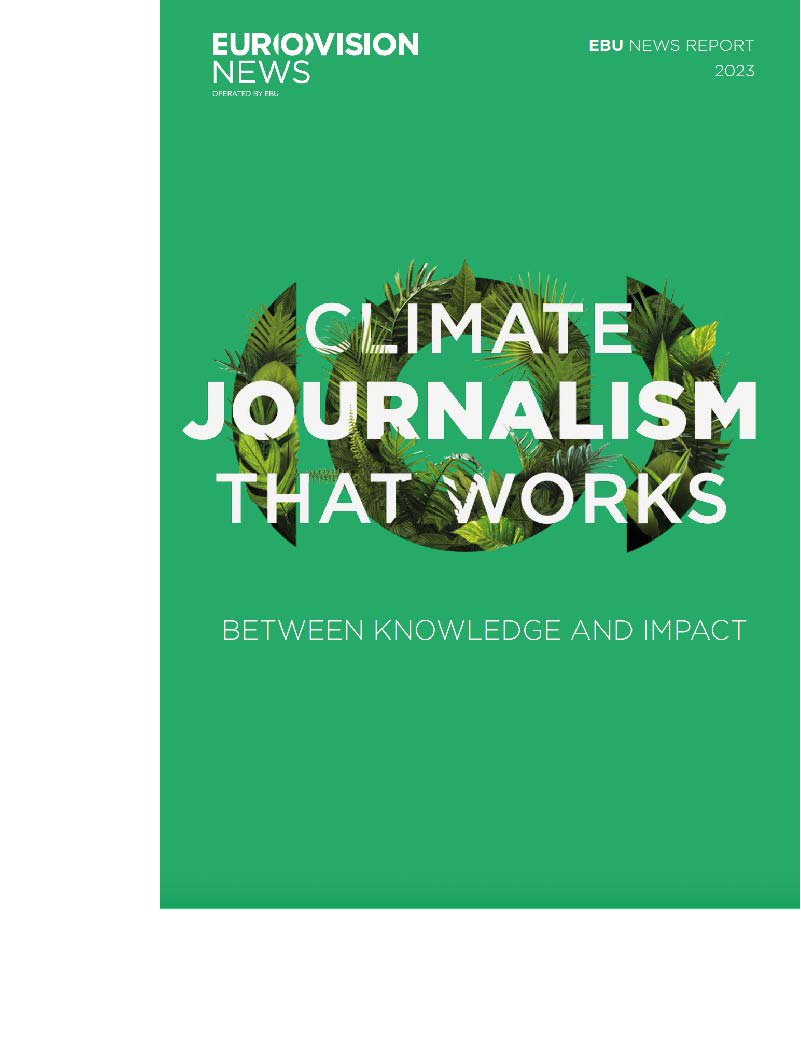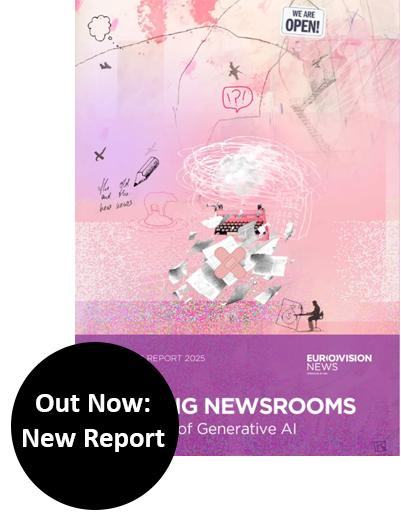If you work in the media industry and want to feed your pessimism, the Digital News Report 2025 makes it easy for you, because this is what it tells you: influencers are challenging established media brands right and left, news avoidance is at an all-time high, and it is becoming increasingly difficult (and costly!) to reach audiences because they are spread across even more platforms – sorted according to political preferences and educational level.. Welcome to the journalistic dreariness of the propaganda age! However, if you want to pave the way for journalism’s future, the only thing that helps is to look at things through the optimist’s glasses. And through these, the media world looks much friendlier already. Here are a few encouraging findings from the publication by the Reuters Institute for the Study of Journalism at the University of Oxford, whose material media professionals like to dissect and discuss:
Firstly, trust in established media is stable. This has been true for the global average for three years – this time, the report covers around 100,000 online users in 48 markets – but also for Germany, where the long-term study on media trust conducted by the University of Mainz recently recorded similar figures. Yes, things looked even better in Germany ten years ago. But the figure currently stands at 45 percent (Mainz study: 47 percent), which is respectable by international standards. As elsewhere, public broadcasters perform particularly well. In addition, the researchers note that users of all age groups prefer traditional media brands when they doubt the veracity of information. The oft-repeated narrative of dwindling trust in the media cannot be substantiated this year either – although trust in the media and media usage are two different things.
Secondly, attracting audiences to your own platforms – that can be done. At least, that’s what the Norwegians, Swedes, and Finns have proven. Public broadcasters there have invested heavily in their own video platforms and are very restrictive when it comes to posting their content on platforms such as YouTube or X. The Finnish broadcaster Yle now attracts more users to its platform than all other providers in Finland combined. The study tours to Scandinavia by many media professionals are therefore justified.
Thirdly, energetic journalists can benefit from the influencer trend and successfully start their own businesses.Frenchman Hugo Travers (Hugodecrypte) now reaches as many users aged 35 and under in France as established media brands: 22 percent of them said they had heard of him in the previous week. The audience appreciates the (perceived) authenticity and approachability of such personal brands. The fly in the ointment: many demagogues on the political right have benefited from this so far, and the line between journalism and opinion-making is blurred. Research by the news agency AFP has revealed that politicians in Nigeria and Kenya hired influencers specifically to spread false messages.
Fourthly, willingness to pay remains stable – and there is room for improvement. Okay, the percentage of people who pay for digital journalism averages 18 percent – that could certainly be higher. But it’s also quite something to know that, despite all the free content available online, around one in five people are willing to pay for journalism – in Germany, the figure is 13 percent. The researchers believe that the subscription market is far from exhausted. Where paying is already common practice, the key is to intelligently bundle offerings and create more interesting pricing models that cater to different types of users. Incidentally, regional and local newspapers in Germany stand out in international comparison with their subscription rates. On the one hand, the researchers speculate that this is an expression of federalism and the fact that many users strongly identify with their regions. On the other hand, projects such as data pooling in Drive or Wan-Ifra’s Table Stakes Europe may also have contributed to this success; they encourage the exchange of experiences, networking, and a focus on targeting specific audiences and user needs.
Fifth, text lives on – especially in this part of the world. Yes, there are highly respected experts who predict at AI conferences that the future of journalism lies in chat – specifically, spoken chat. People would rather talk and listen than write and read, they say. Elsewhere, media professionals complain that young users only digest short-form video, if they pay any attention to journalism at all. The figures do not support these claims. Text is still the most important format for 55 percent of users worldwide. This is different in some countries in Asia and Africa, which could also have to do with later literacy rates. But it is definitely still worthwhile for media companies to invest in first-class texts. There is ample evidence that young people also enjoy listening to long podcasts or binge-watching series. Only one thing does not work today and will work less and less as AI delivers decent quality: poor text.
Sixth, the audience is smarter than many journalists believe. When it comes to the use of AI, for example, respondents expect pretty much what is predicted or feared in the industry: journalism production is likely to become cheaper and even faster, while factual accuracy and trustworthiness will decline. Young consumers in particular are skeptical about media use and verify a lot. In countries such as Thailand and Malaysia, where journalism is largely consumed via TikTok and Facebook, users are very well aware that they may be exposed to lies or fantasy news on these platforms. When it comes to “fake news,” 47 percent of respondents consider online influencers and politicians to be the greatest threat, which is likely a realistic assessment. And many users worry that they could miss important stories if media companies personalize their offerings more in order to turn these users into loyal customers.
Incidentally, what respondents worldwide want from journalism is: more impartiality, factual accuracy, transparency, and original research and reporting. Media researchers couldn’t have put it better themselves.
This column was published in German for the industry publication Medieninsider on 17th June 2025.




OXFORD – In most industries, a quality product is easy to identify, thanks to markers like price, brand, and reviews. But in journalism, discerning quality is becoming increasingly complicated, not least because, in the digital age, trusted brands like the BBC or The New York Times, which can be expected to adhere to long-established journalistic standards, are vastly outnumbered by upstart publications, blogs, and community reports.
Not surprisingly, therefore, as claims of “fake news” have proliferated in recent years, trust in news media – established and otherwise – has plummeted. According to the Reuters Institute’s Digital News Report, those who regularly consume news do so with significant skepticism. Only about 50% of users trust the media brands they choose to consume; far fewer trust outlets that they do not use. With too many options and too little confidence in media, nearly one-third of people have given up following the news altogether.
But news journalism is not an expendable luxury. It is a critical public good, enabling citizens to make informed decisions, while helping to hold those in power accountable. It can serve that function only if it is a quality product – and people know that. Delivering such a product, however, is no straightforward task.
The first problem is that there is no clear definition of what constitutes quality journalism, which raises the risk that the standard of “quality” will become a tool of censorship. When Adolf Hitler wanted a book burned, he would assert that it did not meet the “standards” of Nazi ideology. Similarly, a government today could cite quality issues to attack critics’ credibility or to justify denying them journalistic credentials.
Some organizations concerned with the future of the media are trying to circumvent this danger by developing trust indicators. Most notably, the Journalism Trust Initiative, led by Reporters Without Borders, is creating voluntary guidelines and a best-practice framework that will evolve into an official certification process. Some organizations champion traffic-light indicators, like those used in food labeling, while others argue for an ISO 9000 system reminiscent of industrial quality management.
But what, exactly, would these systems be certifying? The most logical answer might seem to be media organizations. But even first-class newsrooms produce plenty of second-class content, owing to factors ranging from a lack of available sources to simple human error. This implies that not all content from a given organization can be trusted equally.
Of course, some organizations have a proven track record of following certain procedures to minimize mistakes and respond to errors that do slip through. But these are likely to be the same organizations that already enjoy significant public trust. Whatever trust they have lost in recent years will not be offset by a new label affirming their quality.
As for the publications that would benefit from such a label, they are more likely to be smaller, newer, and thus poorly equipped to deal with the extra layer of bureaucracy that a certification procedure would entail. Organization-level quality certifications could thus hurt new entrants, while helping incumbents.
The alternative to organization-level certification would be to focus on individual pieces of content. But this would be a herculean task in terms of volume; worse, it could create perverse incentives, as journalists chase certifications in much the same way they now may chase awards, sometimes to the detriment of the work. The German reporter Claas Relotius won multiple awards for his brilliant storytelling before it was revealed that the stories he was telling were not true.
In any case, the question remains what exactly constitutes a quality piece of content. Does it simply have to be fact-based? Does it apply only to serious political and business news, or does it include lifestyle, entertainment, or human-interest stories? These questions are complicated further in the digital ecosystem: some blog posts may count as journalism, but that certainly isn’t the case for all of them.
Journalism will never be like, say, the airline industry, where strict standards and procedures apply to every action and product. But, until recently, it didn’t need to be: journalists adhered to codes of professional and ethical conduct, and were overseen by bodies that took action in the event of a breach. Doing it right was the default – even though the concept of “right” has always been open to interpretation.
That is how societies work. An individual does not need a “trust certification” to participate in a family or community (though China’s government would like to change that). The social contract establishes certain behavioral norms with which people generally comply; labels are needed only when trust is broken.
This is the status quo to which journalism must return. That means, first and foremost, individual organizations taking responsibility for the quality of their content and adhering to a set of rules, including oversight and editing, to ensure it. When this cannot be done within the organization itself – say, when a citizen journalist is operating in an anti-democratic environment – external bodies could do the job.
In establishing such systems, lessons could be learned from collaborative reporting projects like the one that covered the Panama Papers, in which researchers enjoyed individual freedom – ensuring a plurality of voices and healthy competition – but had to meet certain standards. As technology advances, automated fact-checking could also be introduced, especially in less-resourced newsrooms.
In an age of unprecedented access to information, true and otherwise, people of all ages must improve their media literacy. But that does not let media organizations off the hook. With the help of an aware and critical audience, they must monitor themselves and one another, as they have done in the past.